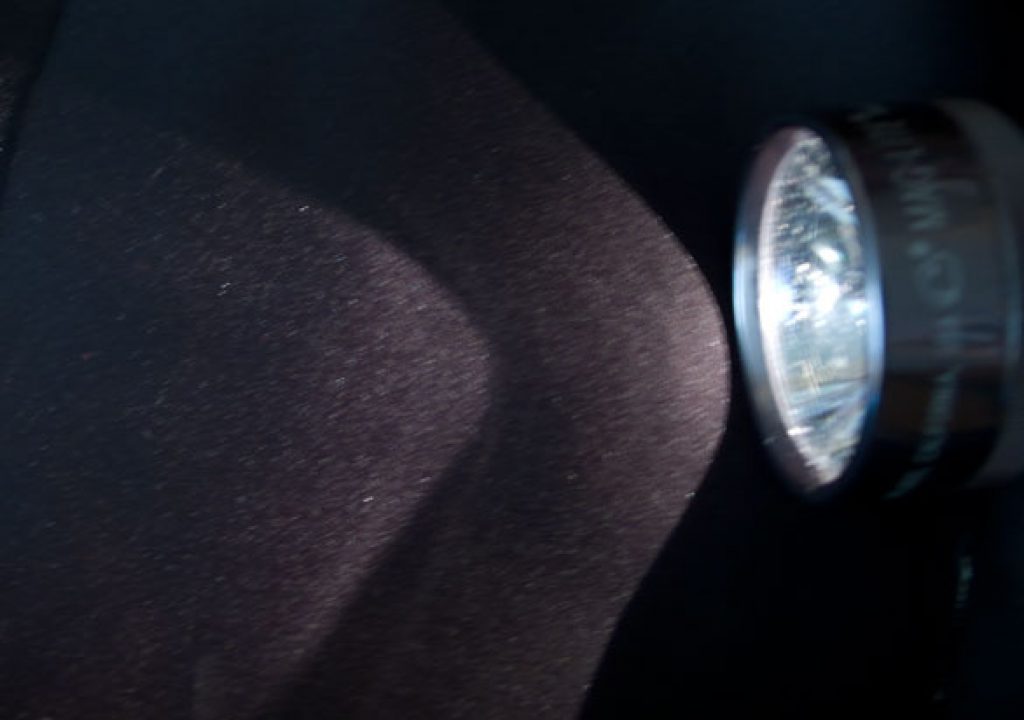During my last round of far red filter testing with the Sony F35/EX1/EX3, director of photography and testing cohort Lenny Levy discovered that far red contamination could be seen by eye under tungsten light simply by viewing fabrics through an ND .90 filter.
This doesn’t work with near infrared, which is what the RED is sensitive too, but as the Sony cameras are oversensitive to red at the edge of the visible spectrum it makes sense that under certain circumstances we should be able to see this without looking through a camera.
I tested this out recently when I set out to create a standardized fabric chart to use when testing hot mirror and far red filters. I went into a fabric store with a flashlight and a Formatt ND .90 filter and I looked at black fabrics of all types. Here are a couple of examples, captured (badly) on a point-and-shoot camera.
This is 100% polyester.
This is 100% polyester viewed through an ND .90 filter. This is how it looked by eye. The magenta cast was very obvious, and is not simply an overall color shift caused by the ND filter.
This is 100% polyester felt made from recycled sources.
This is the same felt through the ND .90. By eye this looked perfectly neutral, but my digital camera picked up some far red/IR and made this picture turn a little magenta.
Note that what you are seeing is NOT overall filter color. ND dyes are rarely neutral and often shift a bit red or magenta, but the Formatts are fairly neutral filters and it was very obvious when a fabric did or did not reflect far red.
In the end I ended up with polyester, rayon, nylon and cotton fabrics that showed clear far red contamination by eye, and two fabrics (one polyester and one cotton) that show no visible contamination. I’m not sure why I’m getting contamination from cotton, which is a natural fiber, but the implication is that the fabric dye is the culprit. This may cause problems with Sony’s claim that natural fibers are free of far red contamination because a “100% cotton” label doesn’t seem to guarantee clean blacks.
I’m sure the employees at this fabric store wondered what in the hell I was doing, but both the flashlight and the filter were necessary: the filter blocked visible light while passing far red above 680nm, which showed which fabrics reflected far red; and the tungsten flashlight was necessary to provide full spectrum light so that far red was present to be reflected. Under the warm flourescent lighting of the store, far red didn’t show up at all through the filter. It appeared immediately, if it was going to appear at all, the instant I lit a fabric with the flashlight and viewed it through the ND filter.
This may be a good way to find problem fabrics during preproduction without having to rent a camera–at least as long as the camera is one of the three Sony cameras mentioned above that are sensitive to far red. Infrared is a completely different matter, so results will differ on the RED.
Stay tuned. I’ll be testing some new Tiffen far red filters tomorrow. The exciting bit is that they are neutral in color, not green. I’ll be interested to see how well my new fabric color chart works out.
I’ll also be testing cyan Kodak Color Correction filters on the RED to see if they reign in the red in tungsten light without the exposure loss of a blue filter, which cuts both red and green light.
Art Adams is a DP who photographs only the finest fabrics. His web site is at www.artadams.net.

